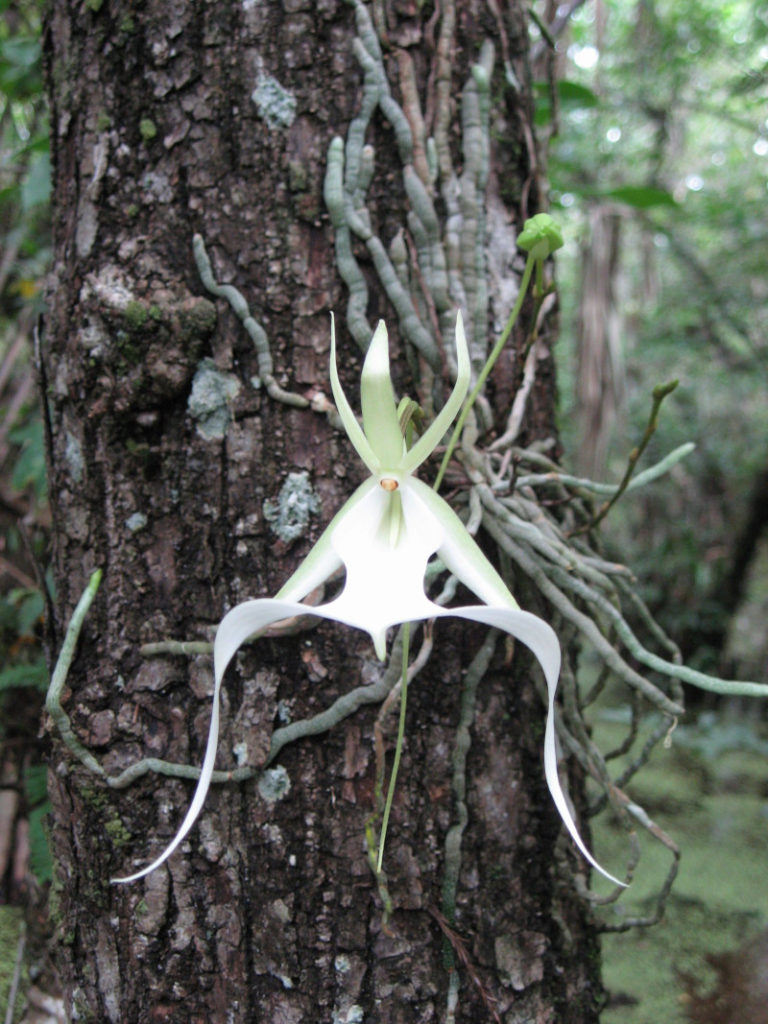
Ghost Orchid Facts
- The gorgeous plant most often known by the common name of the Ghost Orchid represents a truly magnificent species of flora. The fabulous botanical beauty also goes by a few other common names in parts of its native range, however.
- A few of these alternate terms include the white frog orchid and the palm polly. This awesome flowering plant nevertheless also bears another, less memorable appellation. That’s the cumbersome scientific name of Dendrophylax lindenii.
- The Belgian plant collector Jean Jules Linden became the first person to officially recognize the species. The fortuitous discovery of this lovely plant occurred in the year 1844. In doing so, he gave the world a great gift of beauty.
- To the amazement of some, this plant holds a surprise. It bears a close relationship to species native to lands bordering the African and Indian Oceans. This occurs because the members of its genus all evolved during the time of Gondwana.
- Quite sadly, the truly stunning plant called the Ghost Orchid now finds itself in grave peril. This lamentable situation actually occurs due to not merely one problem, but a combination of multiple factors. These include its small range and habitat loss.
- It now also faces other great dangers to its continued existence. Perhaps the greatest of these, though, remains the threat of ongoing climate change. Presently, the IUCN lists it as Endangered on its Red List of Threatened Species.
Related Articles
Ghost Orchid Physical Description
The truly fantastic Ghost Orchid represents one of the orchid varieties that grows as what’s technically known as an epiphyte. That’s because it grows on the surface of another organism and receives its nourishment directly from the air and water.
Within its native habitat, however, this surface most commonly includes the limbs and trunks of trees. The remarkably adapted Angiosperm further displays a relatively strong preference for pop ash and pond-apple trees, though. The reason for this remains unknow.
The visually and physically distinctive variety of orchid typically also develops as a leafless vine. It also remains best known for the gorgeous blooms it produces. The marvelous Ghost Orchid further generally produces between 1 – 10 of these.
Not content to stop there, its blossoms also tend to open only one at at time, prolonging our enjoyment of its appeal. The flowers display a brilliant white color, and average 2.75 – 3.5 in (7 – 9 cm) in length. The same blooms also average 1.2 – 1.6 in (3 – 4 cm) in width.
- Kingdom: Plantae
- Phylum: Tracheophyte
- Class: Monocots
- Order: Asparagales
- Family: Orchidaceae
- Genus: Dendrophylax
- Species: D. lindenii
Ghost Orchid Distribution, Habitat, and Ecology
Quite unfortunately, the magnificent Ghost Orchid evolved to a natural range that poses it numerous problems. That’s because it appears in a portion of the globe that’s both extremely limited and restricted. These zones of habitation are also highly isolated.
In point of fact, the beautiful and delicate Angiosperm occurs in the wild in only two small portions of the world. To the amazement of some, these isolated locations include the island of Cuba, and the state of Florida, in the United States, in North America.
Its own nature tends to make it difficult for the beautiful plant to prosper, however. Regrettably, those same traits also make it even more complicated for it to spread in any numbers. That’s because the species of flora only appears naturally in very specific areas.
These extremely selective areas comprise regions consisting primarily of damp, swampy forests. But wait, there’s more yet to come. The fabulous, but highly selective plant also requires the presence of specific tree species in sufficient abundance.
The breathtaking Ghost Orchid also holds yet another distinction. That holds true due to the fact that its physical nature remains extremely uncommon among Monocots. Its leaves and stem have been reduced to almost non-existence.
As a result, the great majority of its mass now holds a most bizarre-seeming appearance. In point of fact, most of its form now consists of its many branching, hair-like roots. Finally, it’s also pollinated almost exclusively by a variety of moths, further distinguishing it.
Species Sharing Its Range
Check out our other articles on 6 Startling Evolutionary Adaptations, Pesquet’s Parrot, Snoqualmie Falls, Iridescent Bark Mantis, Chilean Dolphin, Balsam Fir, Eastern Diamondback Rattlesnake
